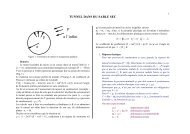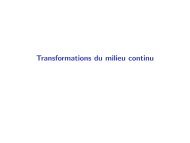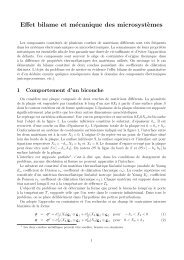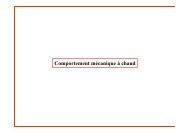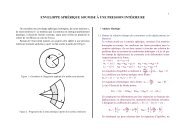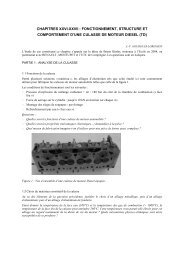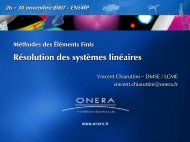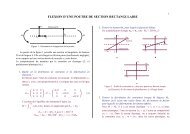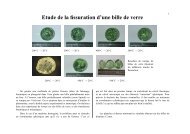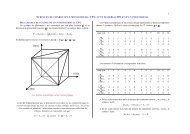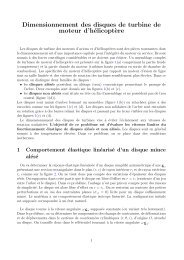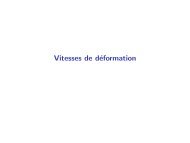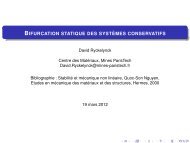Introduction à la théorie des poutres - mms2 - MINES ParisTech
Introduction à la théorie des poutres - mms2 - MINES ParisTech
Introduction à la théorie des poutres - mms2 - MINES ParisTech
Create successful ePaper yourself
Turn your PDF publications into a flip-book with our unique Google optimized e-Paper software.
Théorie de Timoshenko<br />
Calcul <strong>des</strong> travaux virtuels.<br />
⋆ Travail virtuel <strong>des</strong> efforts internes<br />
∫<br />
W ∗<br />
int = − ε ∗ ij σ ij dV (4)<br />
Ω<br />
∫<br />
= − (ε ∗ 11 σ 11 + 2ε ∗ 13 σ 13)dV (5)<br />
Ω<br />
∫<br />
= −<br />
C<br />
( ∫<br />
∫<br />
∫ )<br />
U ∗ ,1 σ 11 dS + θ ∗ ,1 x 3 σ 11 dS + (V ∗ ,1 + θ∗ ) σ 13 dS dx 1 (6)<br />
S<br />
S<br />
S<br />
On introduit alors naturellement les quantités N, T , M conjuguées de U ∗ ,1 , (V ∗ ,1 + θ∗ ), θ ∗ ,1 . Par<br />
définition ce sont l’effort normal, l’effort tranchant et le moment fléchissant (exprimé au point G).<br />
∫<br />
∫<br />
∫<br />
N = σ 11 dS T = σ 13 dS M = x 3 σ 11 dS (7)<br />
S<br />
S<br />
S<br />
Ce sont les composantes du torseur <strong>des</strong> efforts intérieurs. Ceci donne :<br />
∫ (<br />
)<br />
Wint ∗ = − N U,1 ∗ + M θ∗ ,1 + T (V ,1 ∗ + θ∗ ) dx 1 (8)<br />
C<br />
MMS 2012, Théorie de Timoshenko <strong>Introduction</strong> à <strong>la</strong> théorie <strong>des</strong> <strong>poutres</strong> 9/28



